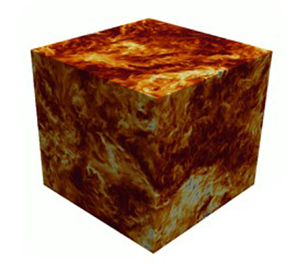Crossref Citations
This article has been cited by the following publications. This list is generated based on data provided by
Crossref.
Suzuki, Jorge L.
Tuttle, Tyler G.
Roccabianca, Sara
and
Zayernouri, Mohsen
2021.
A Data-Driven Memory-Dependent Modeling Framework for Anomalous Rheology: Application to Urinary Bladder Tissue.
Fractal and Fractional,
Vol. 5,
Issue. 4,
p.
223.
Seyedi, S. Hadi
and
Zayernouri, Mohsen
2022.
A data-driven dynamic nonlocal subgrid-scale model for turbulent flows.
Physics of Fluids,
Vol. 34,
Issue. 3,
Ferrari, Simone
Rossi, Riccardo
and
Di Bernardino, Annalisa
2022.
A Review of Laboratory and Numerical Techniques to Simulate Turbulent Flows.
Energies,
Vol. 15,
Issue. 20,
p.
7580.
Seyedi, S. Hadi
Akhavan-Safaei, Ali
and
Zayernouri, Mohsen
2022.
Dynamic nonlocal passive scalar subgrid-scale turbulence modeling.
Physics of Fluids,
Vol. 34,
Issue. 10,
Hosseini, Vahid Reza
Koushki, Masoumeh
and
Zou, W.-N.
2022.
The meshless approach for solving 2D variable-order time-fractional advection–diffusion equation arising in anomalous transport.
Engineering with Computers,
Vol. 38,
Issue. S3,
p.
2289.
Akhavan-Safaei, Ali
and
Zayernouri, Mohsen
2023.
A non-local spectral transfer model and new scaling law for scalar turbulence.
Journal of Fluid Mechanics,
Vol. 956,
Issue. ,
Suzuki, Jorge L.
Gulian, Mamikon
Zayernouri, Mohsen
and
D’Elia, Marta
2023.
Fractional Modeling in Action: a Survey of Nonlocal Models for Subsurface Transport, Turbulent Flows, and Anomalous Materials.
Journal of Peridynamics and Nonlocal Modeling,
Vol. 5,
Issue. 3,
p.
392.
Barros de Moraes, Eduardo A.
D’Elia, Marta
and
Zayernouri, Mohsen
2023.
Machine learning of nonlocal micro-structural defect evolutions in crystalline materials.
Computer Methods in Applied Mechanics and Engineering,
Vol. 403,
Issue. ,
p.
115743.
El-Abed, Amel
Dahy, Sayed A.
El-Hawary, H. M.
Aboelenen, Tarek
and
Fahim, Alaa
2023.
High-Order Chebyshev Pseudospectral Tempered Fractional Operational Matrices and Tempered Fractional Differential Problems.
Fractal and Fractional,
Vol. 7,
Issue. 11,
p.
777.
Akhavan-Safaei, Ali
and
Zayernouri, Mohsen
2023.
A Parallel Computational–Statistical Framework for Simulation of Turbulence: Applications to Data-Driven Fractional Modeling.
Fractal and Fractional,
Vol. 7,
Issue. 6,
p.
488.
Liu, Qiang
Zhu, Wei
Jia, Xiyu
Ma, Feng
Wen, Jun
Wu, Yixiong
Chen, Kuangqi
Zhang, Zhenhai
and
Wang, Shuang
2024.
The anisotropic graph neural network model with multiscale and nonlinear characteristic for turbulence simulation.
Computer Methods in Applied Mechanics and Engineering,
Vol. 419,
Issue. ,
p.
116543.
Akhavan-Safaei, Ali
and
Zayernouri , Mohsen
2024.
DEEP LEARNING MODELING FOR SUBGRID-SCALE FLUXES IN THE LES OF SCALAR TURBULENCE AND TRANSFER LEARNING TO OTHER TRANSPORT REGIMES
.
Journal of Machine Learning for Modeling and Computing,
Vol. 5,
Issue. 1,
p.
1.
Zhang, Fei-Chi
Xie, Jin-Han
Chen, Song Xi
and
Zheng, Xiaojing
2024.
Robust relation of streamwise velocity autocorrelation in atmospheric surface layers based on an autoregressive moving average model.
Journal of Fluid Mechanics,
Vol. 981,
Issue. ,
Chhetri, Santosh
Naghibolhosseini, Maryam
and
Zayernouri, Mohsen
2025.
Simulation of stochastic discrete dislocation dynamics in ductile Vs brittle materials.
Computational Materials Science,
Vol. 247,
Issue. ,
p.
113541.

 $(\varDelta +\lambda )^{\alpha } (\cdot )$, for
$(\varDelta +\lambda )^{\alpha } (\cdot )$, for  $\alpha \in (0,1)$,
$\alpha \in (0,1)$,  $\alpha \neq \frac {1}{2}$ and
$\alpha \neq \frac {1}{2}$ and  $\lambda >0$ in the filtered Navier–Stokes equations. Moreover, we prove the frame invariant properties of the proposed model, complying with the subgrid-scale stresses. To characterize the optimum values of model parameters and infer the enhanced efficiency of the tempered fractional subgrid-scale model, we develop a robust algorithm, involving two-point structure functions and conventional correlation coefficients. In an a priori statistical study, we evaluate the capabilities of the developed model in fulfilling the closed essential requirements, obtained for a weaker sense of the ideal LES model (Meneveau, Phys. Fluids, vol. 6, issue 2, 1994, pp. 815–833). Finally, the model undergoes the a posteriori analysis to ensure the numerical stability and pragmatic efficiency of the model.
$\lambda >0$ in the filtered Navier–Stokes equations. Moreover, we prove the frame invariant properties of the proposed model, complying with the subgrid-scale stresses. To characterize the optimum values of model parameters and infer the enhanced efficiency of the tempered fractional subgrid-scale model, we develop a robust algorithm, involving two-point structure functions and conventional correlation coefficients. In an a priori statistical study, we evaluate the capabilities of the developed model in fulfilling the closed essential requirements, obtained for a weaker sense of the ideal LES model (Meneveau, Phys. Fluids, vol. 6, issue 2, 1994, pp. 815–833). Finally, the model undergoes the a posteriori analysis to ensure the numerical stability and pragmatic efficiency of the model.